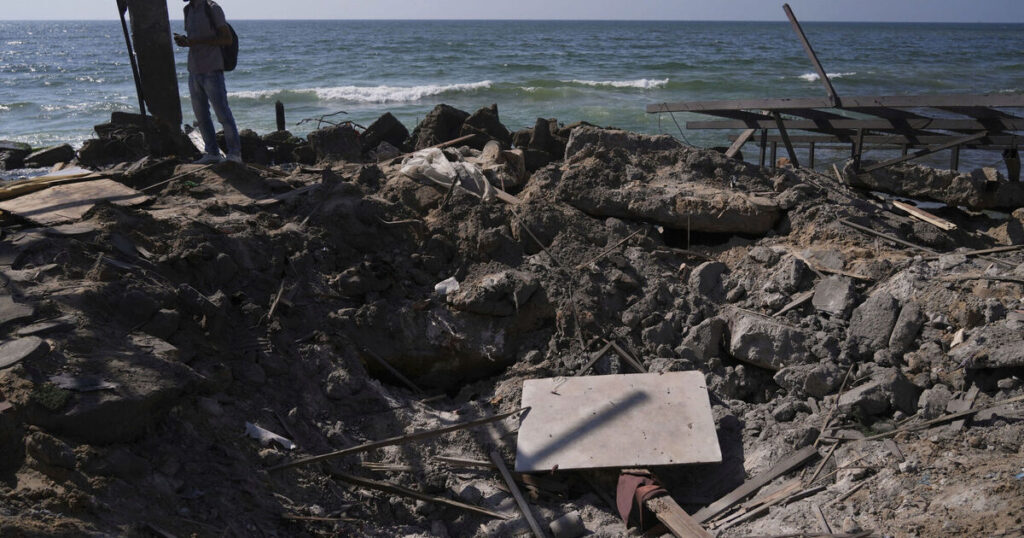Evidence obtained by the Guardian indicates the Israeli military employed a 500lb (230kg) bomb in an attack on a beachfront cafe in Gaza on Monday. This type of weapon is considered powerful and indiscriminate, creating a large blast radius and widespread shrapnel.
International law experts suggest using such a munition in an area with known civilian presence, including children, women, and the elderly, is likely unlawful and may constitute a war crime.
Ordnance experts have identified fragments of the weapon from the Al-Baqa cafe ruins, photographed by the Guardian, as belonging to an MK-82 general-purpose 230kg bomb, a common US-made weapon used in numerous bombing campaigns.
The large crater left by the explosion further corroborates the use of a sizable and potent bomb like the MK-82, according to two ordnance experts.
An Israel Defense Forces (IDF) spokesperson stated that the attack on the cafe is under review and that “prior to the strike, steps were taken to mitigate the risk of harming civilians using aerial surveillance.”
Medical officials reported that the attack resulted in the deaths of between 24 and 36 Palestinians and injured dozens more. Among the deceased were a filmmaker, an artist, a 35-year-old housewife, and a four-year-old child. A 14-year-old boy and a 12-year-old girl were among those injured.
International law, based on the Geneva Conventions, prohibits military forces from launching attacks that cause “incidental loss of civilian life” that is “excessive or disproportionate” to the anticipated military advantage.
Although interpretations vary, experts suggest that only a target whose elimination could significantly impact the conflict’s course could justify the deaths of dozens of civilians.
The Al-Baqa cafe featured two levels: an open upper deck and a lower floor with large windows facing the beach and sea. Its approaches were clearly visible from above.
Gerry Simpson of Human Rights Watch stated, “The Israeli military hasn’t specified the target but mentioned using aerial surveillance to minimize civilian casualties, implying awareness of the cafe’s crowded state.”
He added, “The military would also have been aware that using a large, guided bomb would result in many civilian deaths and injuries. The use of such a weapon in a crowded cafe raises concerns about an unlawful, disproportionate, or indiscriminate attack, warranting a war crime investigation.”
Dr. Andrew Forde, an assistant professor of human rights law at Dublin City University, described the strike as shocking.
He said, “The use of heavy munitions, particularly in crowded civilian spaces, even with precise targeting, will inherently lead to indiscriminate consequences that violate the Geneva Conventions.”
The family-owned Al-Baqa cafe, established nearly 40 years ago, was a popular recreational spot for young people and families in Gaza City, offering a limited selection of soft drinks, tea, and biscuits.
Despite widespread malnutrition and the threat of famine affecting most of Gaza’s 2.3 million residents, some possess savings or salaries enabling them to frequent the few remaining cafes.
The port area where Al-Baqa cafe was located was not subject to any evacuation orders issued by the IDF to warn of impending military operations.
Marc Schack, an associate professor of international law at the University of Copenhagen, stated, “It is almost impossible to justify the use of that type of munition. If you are talking about 20, 30, 40 or more civilian casualties, usually that would have to be a target of very great importance… For coalition forces in Afghanistan and Iraq, the accepted number for a very high-level target was less than 30 civilians getting killed, and only then in exceptional circumstances.”
Trevor Ball, a weapons researcher and former US army explosive ordnance disposal technician, identified a Jdam tail section and thermal battery, suggesting the use of either an MPR500 or an MK-82 bomb.
Another expert with extensive experience in recent conflicts corroborated this identification. A third expert stated an unreliable assessment could be made based on given images.
Israel possesses a wide variety of munitions and commonly utilizes smaller weapons for targeted strikes against individuals in Gaza, Lebanon, and in its recent air offensive in Iran.
The IDF stated earlier this year that even the most sophisticated measures for assessing civilian harm are rarely perfect, and the choice of munitions is “a professional matter contingent on the nature of the strike’s objective.”
The statement further said: “While some targets are suitable for smaller payloads, others may require heavier munitions to achieve mission success – for example, when intending to destroy structures that are built with certain hard materials, large structures, or underground tunnel.” On Tuesday, an Israeli government spokesperson said the IDF “never, ever targets civilians”.
Israel has consistently accused Hamas of employing civilians as human shields, a charge denied by the militant Islamist group.


